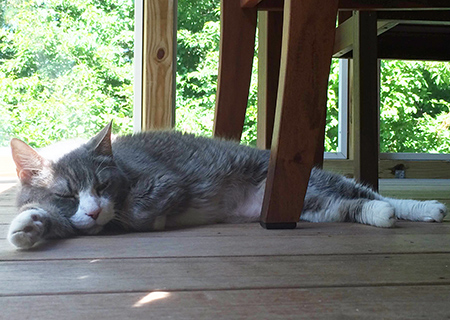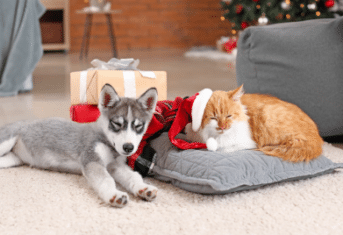Feline Bladder Disease
Feline Bladder Disease
 My feline patient, Rerun van Pelt, did not have a fun 4th of July. Neither did his family. Rerun spent the holiday weekend urinating blood tinged urine outside the cat box. That behavior got him a trip to the animal ER and he spent the rest of the weekend locked in the bathroom to salvage the carpets.
My feline patient, Rerun van Pelt, did not have a fun 4th of July. Neither did his family. Rerun spent the holiday weekend urinating blood tinged urine outside the cat box. That behavior got him a trip to the animal ER and he spent the rest of the weekend locked in the bathroom to salvage the carpets.
FLUTD?
What Rerun had was a case of FLUTD or feline lower urinary tract disease. In the past, FLUTD was called FUS or feline urologic syndrome. Neither FLUTD or FUS are a diagnosis since they can be caused by a variety of conditions, listed here in order of their prevalence:
- Feline idiopathic cystitis (often abbreviated FIC)
- Bladder stones
- Obstruction of the urethra with a conglomeration of inflammatory debris, crystals sloughed bladder tissue, and blood known as a urethral plug
- Behavior disorders
- Urinary tract infection
- Bladder tumors
Surprising to most cat owners is how uncommon urinary tract infections are in cats compared to their frequent occurrence in dogs.
A Trip to the ER?
Male cats, like Rerun, with FLUTD are prone to urinary obstruction or blockage. If urination is not possible due to an obstruction, male cats can become very ill and die because the obstruction prevents waste products from being excreted in the urine. Blood levels of potassium become dangerously elevated in blocked cats. High potassium levels slow the heart beats and can even cause the heart to totally stop beating. Fortunately, Rerun was not obstructed. Even though bladder infections are rare in cats, Rerun had a history of a prior urinary tract infection, so he needed his urine tested for an infection as a precaution.
FIC
Feline idiopathic cystitis, or bladder inflammation of unknown cause, is the most common cause of cats urinating outside the box. Since the cause is currently unknown, treatment is aimed at decreasing the clinical signs. Your veterinarian might prescribe an increase in your cat’s water intake, a canned food diet, pain medications, or medications to reduce straining. A critical component of reducing episodes of FIC is environmental enrichment for your cat. The Ohio State University has a great web resource for cat families on how to help their cat overcome feline idiopathic cystitis and thrive in their home environment.
More Tests
Most cases of FLUTD resolve on their own in about 4 or 5 days. If the FLUTD is recurrent or long lasting, additional testing may be recommended by your veterinarian. These tests might include x-rays to identify bladder stones, an ultrasound of the bladder because some stones don’t show up on x-rays, or a special dye study of the bladder. In some cases, a minimally invasive procedure called cystoscopy is used to visualize of the inside of the bladder without surgery. Less than 2mm in diameter, a cystoscope can be passed up the urethra and into the bladder where its lens and light source allow visualization of the bladder wall.
Litterbox Issues
In Rerun’s case, he was clearly sick because he had blood in his urine and a culture confirmed a relapse of the previous infection. Keep in mind, not all cats that urinate outside the box are sick. Some cats urinate outside the box because of behavior issues. Here are some tips to promote good litterbox behavior in your cat.


































